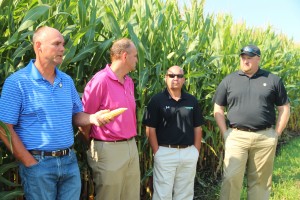
“Pursuit of 300” farmers Matt and Luke Lantz of Lake Crystal speak to reporters about their use of micronutrients to mimic the yield bump they achieve on other fields through addition of manure. With them are Gary Spence of Lake Crystal Coop and Mosaic Co. Director of Product Development Kyle Freeman. Freeman served as the consulting agronomist for the Lantz’ test field.
Written by Jonathan Eisenthal
The Lantz brothers, Matt and Luke, achieve consistently high yields on their Lake Crystal farm where they feed all of their grain to their farrow-to-finish operation (60,000 pigs a year). The total crop land in production is 2,800 acres in rotation, with about a third devoted to soybeans.
“This is not about getting to some high number once, but it’s about increasing by five bushels here with one practice, two bushels there by tweaking something else, and reaching a consistently high yield throughout the whole operation, every year,” Matt said. “Of course, Mother Nature does have a say in this.
Matt spoke on Aug. 22 at a media-only field day organized as a stop along a tour of six farms across the Midwest that have been chosen by Mosaic Co. to take part in a program called “Pursuit of 300,” a comprehensive program designed to look at all aspects involved in achieving high yields.
Speaking of Mother Nature, Luke mentioned his latest calculation that their “Pursuit of 300” field would reach black layer on Oct. 2. They planted mostly 105-day maturity corn varieties, and got the seed in between May 5-15.
The “Pursuit” field has struggled, like much of Minnesota’s corn acres, with a lack of heat units — in late August they were 91 GDDs behind, nearly four full days — a figure that might take eight to 10 days to catch up.
Mosaic company wants to share information about how these farmers achieve successes through a web presence and a magazine called Unfenced. Its “Pursuit of 300” tour wraps up with presentations at their booth at the Farm Progress show in Decatur, Illinois.
Mosaic is working with one farm each in Kansas, Nebraska, Minnesota, Iowa, Illinois and Indiana within its “Pursuit of 300” program, launched last fall.
As a fertilizer company, Minnesota-based Mosaic focuses on potash and phosphates, and has introduced a new line of micronutrients. The company speaks of fertility programs providing 60 percent of what’s needed to reach very high yields. Standing by their “Pursuit of 300” experimental field — a quarter section that routinely produces 225 bu of corn, according to the Lantz brothers –company representatives tout the importance of management practices like precision agriculture and variable plant populations.
Luke Lantz mentions their goal of “singulation” – achieving near total uniformity in the spacing of the plants — all exactly eight inches apart (within 20-inch row spacing) — no drop outs, no doubles. A 99-percent “singulation’ boosts yield measurably, he said.
“Pursuit of 300” creates a team, where the producer works with a Mosaic agronomist alongside the local retailer of Mosaic products, to attempt yield increases through an individualized, experimental plan. Each of the six farmers has devoted at least 100 acres to “Pursuit of 300.”
Kyle Freeman, chief of product development at Mosaic Co., is the agronomist who worked with the Lantz Brothers. They noticed that acres where they spread manure from their livestock operation saw a noticeable yield bump. Though they don’t have enough manure to treat every acre, they wanted to mimic the nutrients the manure makes available.
A soil test determined that Boron was the one micronutrient that could use a boost. In the quarter section, they treated about 100 acres and left 50 acres without added boron, as a control. Tissue sample tests show that the plants did take up more boron where it was applied. Boron comes into play specifically during the pollination phase and is thought to help in grain filling, Freeman said.
Asked about results, Luke Lantz said, “We’ll know at harvest time.”

